Non-uniform information dissemination for performance discovery in computational grids
Abstract
The required service in any resource-sharing environments like Grid, Peer-to-Peer etc., is discovery of resources. A resource discovery mechanism returns locations of resources that match the description, given a description of resource desired. Two resource-sharing environments are well defined with respect to target communities, resources, applications, scalability and fault tolerance: Grid and peer-to-peer systems. Grids are sharing environments that rely on persistent, standards-based service infrastructure that allow location independent access to resources and services, which are provided by geographically distributed machines and networks. The design of the resource discovery approach must follow the rules imposed by the characteristics of grid environment. These characteristics are 1. Independence from central global control, 2. Support for attribute-based search, 3. Scalability, 4. Support for intermittent resource participation. Depending upon the types of resources that are shared, the grids can also be of different types, e.g. computational grids for the environment in which only computational resources are shared, data grids for the one in which data are shared. The focus of thesis is on performance discovery in computational grids.
Grid schedulers, that manages the resources, requires up-to-date information about widely distributed resources in the Grid. This is a challenging problem given the scale of grid, and the continuous change in the state of resources. Several non-uniform information dissemination protocols have been proposed by researchers to efficiently propagate information to distributed repositories, without requiring flooding or centralized approaches. Recently, a new concept called the “Grid potential” proposed in, as the first step towards the design of non-uniform information dissemination protocols.
In this thesis, four non-uniform dissemination protocols are analyzed for computational grids based on the concept of “Grid potential”, which follows above-mentioned requirements for resource discovery. These protocols disseminate resource information with a resolution inversely proportional to the distance of resources from the application launch point. The performance evaluation is done with respect to the dissemination efficiency and message complexity. The results indicate that these protocols improve the performance of information dissemination compared to uniform dissemination to all repositories.
Collections
- M Tech Dissertations [923]
Related items
Showing items related by title, author, creator and subject.
-
Policy based resource allocation on infrastructure as a service cloud
Vora, Dhairya (Dhirubhai Ambani Institute of Information and Communication Technology, 2011)Cloud computing refers to the provision of computational resources on demand. Resource allocation is an important aspect in cloud computing. Cloud user asks for resources in terms of a lease. Lease stores the information ... -
Path complexity of maximum segment sum problem
Mishra, Devesh (Dhirubhai Ambani Institute of Information and Communication Technology, 2009)Various software complexity metrics have been proposed in literature. A program complexity measure called path complexity is proposed in [1]. Path complexity P(A,n) of an algorithm A is defined to be the number of program ... -
On designing DNA codes and their applications
Limbachiya, Dixita (Dhirubhai Ambani Institute of Information and Communication Technology, 2019)Bio-computing uses the complexes of biomolecules such as DNA (Deoxyribonucleic acid), RNA (Ribonucleic acid) and proteins to perform the computational processes for encoding and processing the data. In 1994, L. Adleman ...

